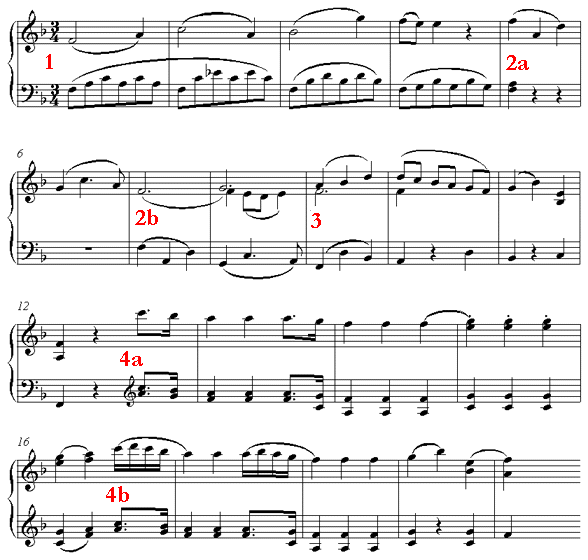 Play MIDI file
Play MIDI file
What makes a hymn sound like a hymn? Of course, there are a number of factors, but fairly prominent amongst these is the harmonic rhythm that is used, at least in traditional hymns. As with Bach's chorales, hymns generally move at a very steady rate, usually at one harmony per beat. This can vary, but the rhythm will usually remain fairly stable throughout. The interesting point is that any material played with this constant, regular harmonic rhythm will tend to sound hymn-like. This is as true of pop and rock music as it is of, say, the 'hymns' of Messaien in the Quator pour le Fin du Temps and Et Expecto Resurrectionem Mortuorum.
See the effect of more complex hymns such as the carol Ding Dong Merrily on High.
Harmonic Rhythm is term describing the rate of change of harmony within a passage of music. Differences in harmonic rhythm play a significant role in effecting our perception of structure and momentum within music, as well as its phraseology.
During the classical period, the role played by harmonic rhythm was fairly stylised. Look at the opening of Mozart's F Major Sonata, Kxxx:
 Play MIDI file
Play MIDI file
During the section labelled 1, there is a regular 1 bar harmonic rhythm. During section 2, this speeds up, at first by melodic implication, and then explicitly in bar 8 (II7 - V). Subsequently, until the beginning of bar 12, there are two harmonies per bar. This phrase-based way of manipulating rhythm is very common in classical music, the basic rule being that as the phrase approached the cadence, the harmonic rhythm would 'speed up' (that is, there are more frequent changes of harmony).
One of the key features of the romantic era was the sense of liberation composers felt regarding both the type of harmonies they could use and the rate at which they could use them. Schubert, while retaining many more classical features, used unusual harmonies in often rather extraordinary rhythms, especially in songs where a sort of 'recitative' was used. Here, large differences in rates of harmonic change often express highly dramatic and expressive ideas.
Often described as at opposite ends of the romantic spectrum, one of the key differences between Brahms and Wagner was not the range of harmonies they used, although Wagner was considered at the time significantly more radical, but in the extent of their control of harmonic rhythm, and the extent to which they used the idea for expressive ends.
Wagner commonly used harmonies for purely dramatic and coloristic effects - a very typical example being the opening of Rheingold, where a chord of E flat major is held and elaborated for a number of minutes. While Brahms was equally able to produce such effects, he in general avoided Wagner's extremes, choosing to emphasise abstract and structural ideas as the vehicle for his expression.
See the opening of Brahms Fourth Symphony and Denn Alles Fleisch... from Ein Deutsches Requiem.
The tweniteth century, and especially the demise of functional harmony, saw an increasingly ambiguous role for harmonic rhythm. It became far easier and more feasible to write music which had no evident harmonic rhythm at all, for instance: